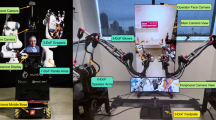Abstract
Stability and transparency determine the performance of bilateral teleoperation systems. Previous studies on passivity-based control focused on stability such that the results of the study are robust in terms of the time delay issue. But there are not sufficient studies on performance analysis based on environmental elements related to transparency. This paper suggests an adaptive wave transformation system where stability is secured by controlling characteristic impedance in the existing wave variables system adaptively according to time delay and environmental elements and simultaneously ensuring a proper dynamic performance depending on external force. Neural network was utilized to design the system that enables controlling the characteristic impedance depending on external factors such as time delay and comparison with the existing wave variables.


















Similar content being viewed by others
References
Lawrence DA (1992) Stability and transparency in bilateral teleoperation. IEEE Trans Robot Autom 9(5):625–637
Natori K, Tsuji T, Ohnishi K, Hace A, Jezemik K (2010) Time-delay compensation by communication disturbance observer for bilateral teleoperation under time-varying delay. IEEE Trans Industr Electron 57(3):1050–1062
Liu F, Wu M, He Y, Yokoyama R (2011) Improved delay-dependent stability analysis for uncertain stochastic neural networks with time-varying delay. Neural Comput Appl 20(3):441–449
Zhang Z, Zhang Y, Chang YW, Chong KT (2011) Time discretization of nonlinear time-delay system using matrix exponential method. Int J Control Autom Syst 9(6):1219–1226
Zhang Y, Chong KT, Kazantzis N, Parlos AG (2012) Discretization of nonlinear input-driven dynamical systems using the Adomian decomposition method. Appl Math Model 36(12):5856–5875
Kumar RR, Chong KT (2012) The stability of distributed neutral delay differential systems with Markovian switching. Chaos, Solitons Fractals 45(4):416–425
Di Cairano S, Bemporad A (2010) Model predictive control tuning by controller matching. IEEE Trans Autom Control 55:185–190
Sheng J, Spong MW (2004) Model predictive control for bilateral teleoperation systems with time delays. Can Conf Electr Comput Eng 4:1877–1880
Gao Y, Chong KT (2012) The explicit constrained min-max model predictive control of a discrete-time linear system with uncertain disturbances. IEEE Trans Autom Control 57(9):2373–2378
Leung GMH, Francis BA, Apkarian J (1995) Bilateral controller for teleoperators with time delay via μ-synthesis. IEEE Trans Robot Autom 11(1):105–116
Cho HC, Park JH, Kim K, Park JO (2001) Sliding mode-based impedance controller for bilateral teleoperation under varying time-delay. Proc IEEE Int Conf Robot Autom 1:1025–1030
Chen M, Jiang B, Jiang CS, Wu Q (2010) Robust control for a class of time-delay uncertain nonlinear systems based on sliding mode observer. Neural Comput Appl 19(7):945–951
Long B, Ryu JH, Chong KT (2013) Optimal switching table-based sliding mode control of an energy recovery Li-Ion power accumulator battery pack testing system. Energies 6(10):5200–5218
Fattouh A, Sename O (2003) Finite spectrum assignment for teleoperation systems with time delay. Proc IEEE Conf Decis Control 6:6060–6065
Haddadi A, Hashtrudi-Zaad K (2010) Bounded-impedance absolute stability of bilateral teleoperation control systems. IEEE Trans Haptics 3(1):15–17
Hannaford B, Fiorini P (1988) A detailed model of bilateral teleoperation. Proc IEEE Int Conf Syst Man Cybern 1:117–121
Anderson RJ, Spong MW (1989) Bilateral control of teleoperators with time delay. IEEE Trans Autom Control 34(5):494–501
Niemeyer G, Slotine E (1991) Stable adaptive teleoperation. IEEE J Oceanic Eng 16(1):152–162
Moussa B, Antoine F (2006) Wave-based passive control for transparent micro-teleoperation system. Robot Auton Syst 24:601–615
Robinson SM (1991) An implicit-function theorem for a class of non-smooth functions. Math Oper Res 16(2):292–309
Park Y, Kazantzis N, Parlos AG, Chong KT (2013) Time discretization of the point kinetic equations using matrix exponential method and first-order hold. Ann Nucl Energy 62:437–444
Nikhi C, Spong MW (2003) Bilateral teleoperation over the internet: the time varying delay problem. Proc Am Control Conf 2003:155–160
Aziminejad A, Tavakoli M, Patel RV, Moallem M (2008) Transparent time-delayed bilateral teleoperation using wave variables. IEEE Trans Control Syst Technol 16(3):548–555
Haykin S (1994) Neural networks. MacMillan, London
Garg S, Pal SK, Chakraborty D (2007) Evaluation of the performance of backpropagation and radial basis function neural networks in predicting the drill flank wear. Neural Comput Appl 8:407–417
Chong KT, Yoo SG (2006) Neural network prediction model for a real-time data transmission. Neural Comput Appl 15:373–382
Atiya AF, Yoo SG, Chong KT, Kim H (2007) Packet loss rate prediction using the sparse basis prediction model. IEEE Trans Neural Networks 18:950–954
Finschi L (1996) An implementation of the Levenberg–Marquardt algorithm, clausiusstrasses 45, CH-8092, Zuerich
Peng CC, Magoulas GD (2010) Nonmonotone Levenberg–Marquardt training of recurrent neural architectures for processing symbolic sequences. Neural Comput Appl 20:897–908
Acknowledgments
This work was partially supported by the National Research Foundation of Korea (NRF) grant funded by the Korea government (MEST) (no. 2013-009458) and (no. 2013-068127) and Honam Regional Leading Research Project (no. G02A00460046602).
Author information
Authors and Affiliations
Corresponding author
Rights and permissions
About this article
Cite this article
Yoo, S.G., Chong, K.T. Adaptive wave variables for bilateral teleoperation using neural networks. Neural Comput & Applic 25, 1249–1262 (2014). https://doi.org/10.1007/s00521-014-1606-0
Received:
Accepted:
Published:
Issue Date:
DOI: https://doi.org/10.1007/s00521-014-1606-0



